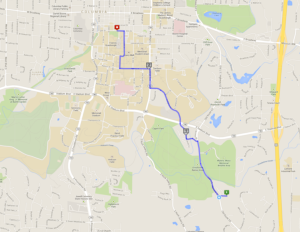In our first story by a student writer, Curbing Cars presents this tale of trading driving for walking.
By Lauren Steele
Walking out of the Ragtag Cinema in downtown Columbia, Missouri with a friend last August, our conversation quickly went from Silver Linings Playbook to an Ashton Kutcher film from a few years back.
“Dude, where’s your car?”
My smug chuckle was quickly gagged with a lump in my throat and the realization that my friend was not quoting the movie. My car was gone.
We interrogated some car-towing witnesses and took a cab to a sketchy gas station, where I was reunited with my Pontiac. After writing a $160 check to retrieve it, I made a resolution—my car was getting curbed.
I had a few transportation options, such as the free shuttles that ran from my apartment complex, riding a bike, or walking. As a small-town farm girl and a dedicated runner, I considered each choice with a certain dogged stubbornness.
The shuttle seemed like a lazy option and I didn’t want to wrap my schedule around its pick-up times. My bike was a rusted out piece of unreliability, and the hills of Columbia beat most cyclists, leaving them pushing their bikes and hoofing it.
If I was going to have to walk, I figured I might as well go all or nothing, and walk the whole way. Plus, Columbia caters to pedestrians with lots of trails, great sidewalks and crosswalks that don’t favor drivers.
The three-mile march to the University of Missouri’s campus did not cause me the least bit of hesitation. Nor did it occur to me that my decision might seem excessive to people. I would lose an hour of sleep in the morning, and an hour of evening time to walking. But, that seemed like a small sacrifice, especially when compared with the hefty towing fines that my student-sized pocketbook could not accord.
So, I got started. Up until then, my style could be described as always-running-late. Those first few mornings to campus started a good hour and a half before my first class, since my route choices and travel time had to be determined.
Breezing on past the shuttle, I saw looks on curious faces that undeniably read, “Why the dreaded heck is that crazy girl not getting on this bus?” Over the course of the year, the thought entered my mind more than once that my fellow 7 a.m. commuters probably considered me the “insane girl who walks every day.” (Lots of thoughts enter your mind when you spend enough time being quiet and just taking step after step.)
But when I got to Mizzou’s bustling campus, I was in good company. Everyone there was on foot getting from class to class or the downtown district where people mosey in and out of cafes, vintage shops and locally owned restaurants. That is also where cars get towed. It explains why everyone is walking—meters and tickets are not nearly as convenient as putting one foot in front of the other.
 Sometimes the trek seemed like an Indiana Jones-esque adventure. Mother Nature, the City of Columbia and sometimes even my own body did not care to ensure each day as a walk in the park—pun intended. Ponchos, galoshes and umbrellas kept me from looking like a drowned rat during class lectures.
Sometimes the trek seemed like an Indiana Jones-esque adventure. Mother Nature, the City of Columbia and sometimes even my own body did not care to ensure each day as a walk in the park—pun intended. Ponchos, galoshes and umbrellas kept me from looking like a drowned rat during class lectures.
The exception was one drive-by splash, courtesy of a campus shuttle, that left me dripping and sputtering choice words. During “Snowpocalypse 2013″ in mid-March, all of Columbia’s sidewalks disappeared beneath snow and ice for about two weeks. My walks became freezing hikes.
Rain, sleet and snow weren’t only my hindrances. City construction sites were as well. The crew that was working on my daily route came to expect my passing by. We would trade greetings and small talk as I finagled my way through their work zone.
When a stress fracture slowed me down in September and left me in a clunky walking boot, the workers asked if it was a smart idea to keep on with the walking. There were concerned looks under their hardhats. It showed just how much the daily pleasantries had invested them in “the insane girl who walks everyday.” And now I was “the insane girl who walks everyday with a broken foot.”
I didn’t recruit my car as a “Plan B” because my walk didn’t feel like an obligation. It became my friend.
This sounds strange, but I was fond of the Grindstone Creek that flows full of smooth stones and clear water, and the stable wooden bridge that it runs under. The stripped white sycamore trees that rise up all around became daily presences for me. The elements of my walk—the good, the bad and the ugly—were my constant companions.
Dodging cars across Stadium Boulevard, the busiest street in Columbia, woke me up like most people’s double espressos. The mornings went from being dreaded sleep-stealers to refreshing sunrise adventures for me.
After all of the miles, the time and the steps taken each day since my car got curbed, I am still walking. I have grown to love the time I get to spend away from my email, my phone and obligations. This unconventional commute has become crucial daily time out in the great outdoors and with my thoughts.
The benefits exceed far beyond the tickets and towing fees that were the initial decision makers of this lifestyle change. Yes, I can now go three weeks away from the gas pump, but the real reward is the three miles I get to spend with myself.
On August 18, I started my senior year off with a walk to my first class of the Fall 2013 semester. I know this year will bring just as many adventures afoot as the last.
Changing Gears welcomes story ideas from students, especially about transportation topics where you live or go to school. Contact us at curbingcars@gmail.com

